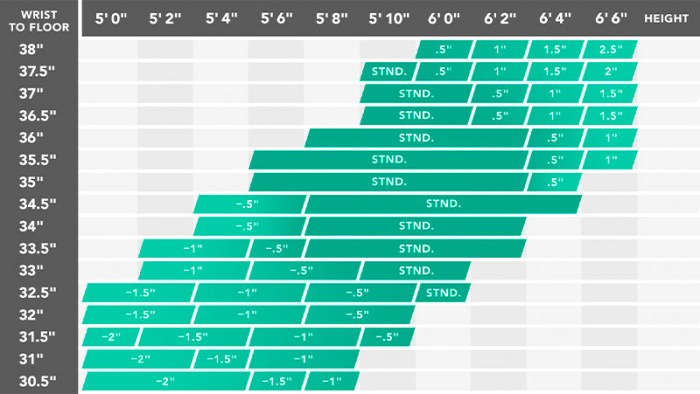How to measure driver shaft length is crucial for golfers seeking optimal performance. Understanding the precise shaft length tailored to your physique and swing is key to maximizing distance, accuracy, and enjoyment on the course. This guide will delve into the various methods and factors to consider, equipping you with the knowledge to measure your driver shaft length accurately and effectively.
From detailed explanations of different shaft length options and their effects on club head speed and launch angle, to practical step-by-step measurement techniques using different tools, this comprehensive guide will equip you with the knowledge to measure your driver shaft length accurately. We’ll also discuss how your height, build, swing characteristics, and experience level impact your shaft length selection. Armed with this information, you can confidently choose the perfect driver shaft length to elevate your game.
Understanding Driver Shaft Length
Driver shaft length is a crucial factor in golf performance. Different lengths cater to various player profiles, impacting club head speed, launch angle, and carry distance. Understanding these relationships is key to selecting the optimal shaft length for individual needs and maximizing golf performance.
Driver Shaft Length Options
Golfers have a variety of driver shaft lengths available, typically ranging from 42 inches to 46 inches. Shorter shafts generally suit players with shorter statures or slower swing speeds. Longer shafts are often preferred by taller players with faster swing speeds. Shaft length selection involves careful consideration of individual swing characteristics and preferences.
Relationship Between Driver Shaft Length and Club Head Speed, How to measure driver shaft length
Driver shaft length directly influences club head speed. Longer shafts, generally, facilitate greater club head speed due to the increased leverage and swing path length. Shorter shafts, conversely, often result in lower club head speeds. The relationship is not a simple linear one; factors like swing mechanics and player strength also contribute significantly.
Impact of Shaft Length on Launch Angle and Carry Distance
Driver shaft length affects launch angle and carry distance. Longer shafts typically produce a lower launch angle, which often translates to a greater carry distance, though this isn’t always the case. A lower launch angle is sometimes preferable for players seeking maximum distance, especially with high club head speeds. Shorter shafts tend to produce a higher launch angle, which might be better for players aiming for greater forgiveness.
Common Driver Shaft Lengths and Player Profiles
Common driver shaft lengths, their typical swing speeds, and player profiles include:
- 42-43 inches: Suitable for players with shorter statures, slower swing speeds, and those who prefer a higher launch angle for greater forgiveness. A player with a 75 mph swing speed might find this length suitable.
- 43.5-44.5 inches: A popular choice for a broad range of players. It can work well for players with moderate swing speeds and heights who desire a balance of distance and forgiveness.
- 44.5-45.5 inches: Often favored by players with above-average swing speeds and heights. These players often prioritize maximum distance with a slightly lower launch angle.
- 45.5-46 inches: Tailored for players with very fast swing speeds and height, aiming for maximum distance with a lower launch angle. A player with an 85 mph swing speed might find this length suitable.
Driver Shaft Length, Swing Speed, and Launch Angle
The table below demonstrates a simplified relationship between driver shaft length, typical swing speeds, and corresponding launch angles. Actual results will vary based on individual swing mechanics and other factors.
| Shaft Length (inches) | Typical Swing Speeds (mph) | Corresponding Launch Angles (degrees) |
|---|---|---|
| 42 | 70-80 | 15-18 |
| 44 | 80-90 | 13-16 |
| 46 | 90-100 | 11-14 |
Measuring Driver Shaft Length Accurately

Understanding the precise length of your driver shaft is crucial for optimal club performance. A correctly measured shaft length contributes to the proper swing path, impact position, and overall club feel, ultimately leading to more accurate shots and improved golf scores. This section details various methods for accurate measurement, emphasizing precision and avoiding common errors.Accurately measuring the driver shaft length is essential for maximizing performance and efficiency.
Precise measurement ensures a proper swing, enabling better ball striking, improving consistency, and achieving optimal performance.
Methods for Measuring Driver Shaft Length
Several methods can be employed to measure driver shaft length. Each method has its own advantages and disadvantages, impacting accuracy and ease of use. Careful consideration of these factors is important for obtaining a reliable measurement.
Using a Ruler or Measuring Tape
A ruler or measuring tape is a common and readily available tool for measuring driver shaft length. However, accuracy depends heavily on the user’s precision and the quality of the measuring instrument.
Step-by-Step Guide Using a Measuring Tape
This guide details the process of accurately measuring driver shaft length using a measuring tape. Following these steps ensures a reliable measurement and minimizes errors.
- Secure the club: Place the driver on a stable, flat surface. Ensure the club head is firmly resting on the surface, preventing any movement during the measurement process.
- Position the measuring tape: Carefully position the measuring tape’s zero point at the very end of the grip. Ensure the tape is aligned directly against the grip, avoiding any bending or distortion.
- Extend the tape: Extend the measuring tape along the shaft’s length, ensuring it is positioned straight and parallel to the shaft’s axis.
- Read the measurement: Read the measurement at the point where the tape meets the club head. Ensure the tape is in contact with the club head’s sole (the bottom part of the club head) and not on any projections or markings. Record the measurement precisely.
- Verify the measurement: Repeat the process to confirm the measurement. Any significant difference in the measurements indicates a potential error, so recheck the alignment and position of the measuring tape.
Comparison of Measurement Tools
Different tools offer varying degrees of accuracy and ease of use. The choice of tool depends on the user’s needs and resources.
| Method | Accuracy | Ease of Use | Cost |
|---|---|---|---|
| Ruler | Moderate | High | Low |
| Measuring Tape | High | High | Low |
| Digital Measuring Device | High | High | Medium to High |
Factors Influencing Driver Shaft Length Selection

Understanding the ideal driver shaft length is crucial for optimal performance. It’s not just about selecting a club; it’s about aligning the tool with the golfer’s unique physical and swing characteristics. Different factors play a significant role in determining the best shaft length for each individual.
Height and Build
Golfer’s height and build significantly influence the optimal driver shaft length. Taller golfers generally benefit from longer shafts, allowing for a more natural swing path and maximizing their reach. Conversely, shorter golfers typically perform better with shorter shafts, which facilitates a more controlled swing and reduces the need for excessive reach. Body proportions, including arm length and torso length, also play a part.
An individual with longer arms might find a shorter shaft more beneficial, and vice-versa. Consideration of the overall body proportions and center of gravity is vital in achieving a balanced swing.
Swing Characteristics
Swing speed and tempo are key factors in determining the appropriate driver shaft length. Faster swing speeds often necessitate a slightly longer shaft to maintain a consistent swing plane and reduce the potential for excessive club head speed. A slower tempo, on the other hand, might be more effectively managed with a shorter shaft, which can encourage a more controlled swing.
An understanding of how the golfer’s tempo affects their swing is critical.
Experience Level
Experience level also plays a significant role in driver shaft length selection. Beginners and intermediate golfers might benefit from a slightly longer shaft, which can promote a more consistent swing and increase forgiveness. Experienced golfers, often with a more refined swing, can often utilize shorter shafts to enhance control and precision. Experienced players often have a better understanding of their swing mechanics and can leverage the precision that a shorter shaft offers.
Individual Swing Characteristics
Individual swing characteristics are paramount in selecting the right driver shaft length. The golfer’s swing path, angle of attack, and release point all contribute to the ideal shaft length. A golfer with a steep angle of attack might benefit from a longer shaft to compensate for the increased club head speed. A golfer with a more upright swing path might find a shorter shaft more conducive to maintaining control.
The subtle nuances in swing mechanics need to be carefully considered to select the optimal shaft length.
Body Mechanics
Body mechanics directly impact the optimal driver shaft length. A golfer with a balanced stance and a smooth, controlled swing can often leverage a shorter shaft. Conversely, a golfer with a tendency towards a more forceful or inconsistent swing might find a longer shaft to be more beneficial in promoting a smoother swing and a more controlled impact.
Understanding the body mechanics and how they affect the swing path is crucial for finding the ideal shaft length.
Shaft Length Comparison Table
| Player Type | Recommended Length (inches) | Typical Swing Speed (mph) | Expected Impact |
|---|---|---|---|
| Beginner | 45-46 | 70-85 | Increased forgiveness, consistent swing |
| Intermediate | 44-45 | 85-95 | Improved control, balanced swing |
| Advanced | 43-44 | 95-105+ | Enhanced precision, maximum control |
Final Summary
In conclusion, accurately measuring your driver shaft length is paramount for optimizing your golf performance. By understanding the interplay between shaft length, swing characteristics, and individual player attributes, you can select the ideal length for maximum distance, accuracy, and comfort. This guide provides a practical and insightful approach to ensure you measure your driver shaft length effectively and achieve the best possible results on the course.
Key Questions Answered: How To Measure Driver Shaft Length
What tools are best for measuring driver shaft length?
A measuring tape or ruler is typically recommended for accurate shaft length measurement. However, consider using a dedicated golf club fitting tool for even more precise results.
How does my swing speed affect my driver shaft length selection?
Faster swing speeds often benefit from shorter shafts, while slower swing speeds might benefit from longer shafts. A professional club fitter can provide personalized recommendations.
What is the typical range of driver shaft lengths?
Driver shaft lengths generally range from 42 to 46 inches. The ideal length will vary based on individual factors.
Can I measure my driver shaft length myself, or should I consult a professional?
While this guide provides a step-by-step approach, consulting a professional club fitter is highly recommended for precise and personalized recommendations. They have the expertise to assess your specific needs and ensure optimal shaft length.
